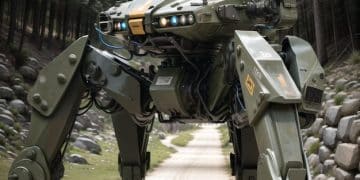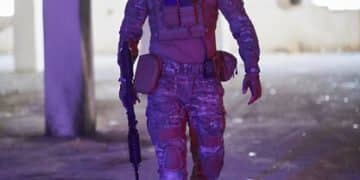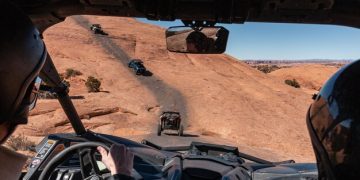How Robotic Combat Vehicles Will Reshape Army Infantry by 2025
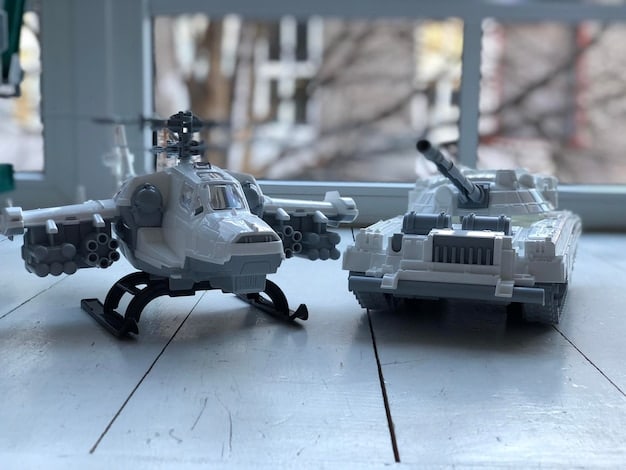
The U.S. Army’s new Robotic Combat Vehicles (RCVs) are poised to fundamentally transform infantry tactics by 2025, enabling dismounted troops to operate with enhanced reconnaissance, lethality, and protection, thereby reducing direct human exposure to battlefield dangers while increasing operational tempo.
The landscape of modern warfare is in constant evolution, pushing armies worldwide to embrace cutting-edge technologies. One of the most talked-about advancements, and a topic of intense development within the U.S. Army, is the integration of Robotic Combat Vehicles (RCVs). The question of How Will the Army’s New Robotic Combat Vehicle Impact Infantry Tactics by 2025? is not merely academic; it’s a critical strategic discussion shaping the future of ground combat operations and the very nature of the infantry soldier.
The Dawn of Robotic Warfare: RCVs in the Modern Battlefield
The introduction of Robotic Combat Vehicles marks a pivotal moment in military history, akin to the tank’s debut in World War I or the widespread adoption of drones in recent conflicts. These unmanned ground systems are designed to operate semi-autonomously or under remote control, extending the reach, sensing capabilities, and protective envelope of infantry units. Their integration by 2025 is not just about adding new equipment; it’s about fundamentally rethinking how dismounted soldiers will engage the enemy, manage risk, and exploit opportunities in complex environments.
What Defines a Robotic Combat Vehicle?
RCVs are not a single, monolithic class of vehicle but rather a family of systems tailored for various roles. The Army is exploring different variants, often categorized by size and payload capacity, such as Light (RCV-L), Medium (RCV-M), and Heavy (RCV-H). Each variant brings distinct capabilities to the battlefield, from reconnaissance and counter-reconnaissance to direct fire support and logistics. The common thread among them is their ability to operate without a human crew onboard, thereby reducing personnel exposure to enemy fire and hazardous conditions.
- RCV-Light: Primarily focused on reconnaissance, surveillance, and target acquisition (RSTA) for infantry.
- RCV-Medium: Offers a balance of RSTA and direct fire support, capable of mounting heavier weapon systems.
- RCV-Heavy: Designed for robust direct fire support, breaching operations, and potentially even casualty evacuation.
These robotic platforms represent a significant leap forward in capabilities. They are equipped with advanced sensors, communications systems, and often, lethal weapon stations. The vision is for RCVs to act as loyal wingmen, extending the infantry’s tactical sphere, absorbing enemy fire, and providing crucial information about the battlespace. This integration will demand changes not only in equipment but also in doctrine, training, and the very mindset of the infantry soldier. Early trials and conceptualizations suggest a future where soldiers work seamlessly with robotic partners, augmenting their collective strengths and mitigating individual vulnerabilities.
Enhanced Reconnaissance and Situational Awareness for Infantry
One of the most immediate and profound impacts of RCVs on infantry tactics will be in the realm of reconnaissance and situational awareness. Traditionally, infantry scouts operate forward, often at significant personal risk, to gather information about enemy positions, terrain, and obstacles. RCVs, particularly the lighter variants, can now perform these dangerous tasks, providing infantry commanders with a clearer, more timely, and more comprehensive picture of the battlefield without directly exposing human personnel to hostile fire. This shift is not just an incremental improvement; it is a paradigm shift in how information dominance is achieved at the tactical edge.
Pushing the Perimeter: RCVs as Forward Scouts
Imagine an infantry platoon approaching a fortified position. Instead of sending human scouts directly into harm’s way, an RCV-L can be dispatched to lead the advance, using its array of sensors—thermal cameras, optical zoom lenses, ground-penetrating radar—to detect enemy presence, identify potential ambushes, and map out safe routes. This allows the dismounted infantry to follow, informed and prepared, with a drastically reduced risk of being surprised. The RCV can navigate complex terrain, enter areas deemed too dangerous for humans, and relay critical intelligence back to the troops in real-time. This capability directly supports the principle of “see first, understand first, act first.”
The data collected by RCVs can be fused with other intelligence sources, presented to infantry leaders through augmented reality displays or battlefield management systems. This creates a multi-layered understanding of the operational environment, enabling more informed decision-making under duress. Soldiers will no longer rely solely on their own limited line of sight or the often-fragmented reports from human scouts. Instead, they will have access to a continuous stream of sensor data, enabling them to anticipate threats and exploit weaknesses with unprecedented precision.
The ability of RCVs to operate autonomously or semi-autonomously in contested environments also frees up human operators from continuous direct control, allowing them to focus on higher-level tactical decisions. This distributed intelligence gathering enhances the overall cognitive load capacity of the infantry unit, making them a more agile and adaptable force. It’s about turning information into a tactical advantage, giving the infantry the edge even before direct engagement begins.
Increased Lethality and Firepower Support
Beyond reconnaissance, the Robotic Combat Vehicle’s capacity for increased lethality and direct fire support represents a transformative development for infantry tactics. Previously, dismounted infantry often faced limitations in organic firepower, relying on heavier mechanized elements or indirect fire support. RCVs can bridge this gap, offering a mobile, protected, and highly accurate source of additional firepower right at the front lines, in direct support of the advancing infantry. This allows infantry units to engage a wider array of threats, from fortified positions to light armored vehicles, with greater confidence and effectiveness.
Acting as Mobile Fire Platforms
RCV-M and RCV-H variants are specifically designed to carry a variety of weapon systems, ranging from medium machine guns and automatic grenade launchers to anti-tank guided missiles and even small cannons. These platforms can move in sync with dismounted infantry, providing immediate suppressive fire or precision engagements against enemy strongpoints. This significantly enhances the infantry’s ability to maintain momentum during an assault, offering a robust protective bubble of fire that can clear obstacles and neutralize threats that would otherwise halt their advance. The ability to bring heavy caliber weapons into close action without exposing human operators is a game-changer for urban combat and battles against well-entrenched adversaries.
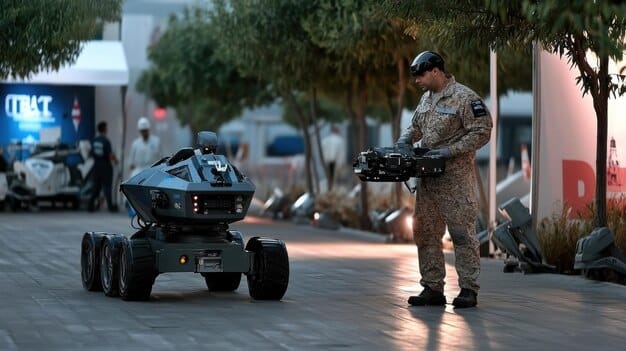
The presence of RCVs also allows infantry units to distribute their firepower more effectively, engaging multiple targets simultaneously or focusing overwhelming force on a single objective. For example, while one RCV provides suppressive fire, dismounted elements can maneuver to flank the enemy. This dynamic interplay between robotic and human assets creates a more versatile and formidable fighting force. Furthermore, RCVs can serve as weapon platforms for specialized munitions, such as loitering munitions or small anti-drone systems, expanding the infantry’s defensive and offensive capabilities against emerging threats. Their robotic nature also enables them to sustain prolonged engagements, acting as a persistent and reliable source of fire support in demanding situations where human perseverance might dwindle.
Enhanced Protection and Risk Mitigation for Soldiers
Perhaps the most compelling argument for the integration of Robotic Combat Vehicles is their unparalleled ability to enhance the protection of infantry soldiers and mitigate risks on the battlefield. The core principle driving RCV development is to put machines in harm’s way instead of humans. This fundamental shift promises to drastically reduce casualties, allowing soldiers to operate in safer conditions while still achieving mission objectives. The psychological impact of knowing a robotic companion can precede them into dangerous zones or absorb enemy fire is also likely to be significant, fostering greater confidence and morale among troops.
Shielding the Dismounted Force
RCVs can act as mobile shields, providing physical cover for advancing infantry in open terrain or during assaults on fortified positions. Their armored hulls can deflect small arms fire, and in some cases, even withstand anti-tank rounds, protecting soldiers from direct exposure. This allows infantry to close the distance with the enemy more safely, or to redeploy under fire with a greater degree of protection. In urban environments, RCVs equipped with observation equipment can clear buildings and street corners before human entry, preventing ambushes and IED threats. The ability to breach doors or walls robotically, or to investigate suspicious packages, means soldiers are not the first ones to face the unknown dangers.
The strategic deployment of RCVs in dangerous zones – such as minefields, chemical attack areas, or choke points – means that human lives are not gambling on these missions. If an RCV is damaged or destroyed, it represents a material loss, not a human tragedy. This allows commanders to take calculated risks that would be otherwise unacceptable with human-crewed vehicles or dismounted scouts. The protection offered extends beyond direct fire; RCVs can carry equipment for identifying and neutralizing chemical, biological, radiological, and nuclear (CBRN) threats, scanning for snipers, or even providing initial casualty assessment in a hostile environment, further isolating soldiers from immediate harm.
Transforming Infantry Formations and Maneuver Warfare
The integration of Robotic Combat Vehicles is set to fundamentally transform traditional infantry formations and redefine the principles of maneuver warfare. For centuries, infantry tactics have largely revolved around human locomotion, fire and movement, and the inherent limitations of human endurance and vulnerability. RCVs introduce a new dynamic, allowing for novel tactical approaches that leverage both manned and unmanned capabilities in complex and synergistic ways. By 2025, infantry units will likely adopt hybrid formations, where humans and robots operate as a cohesive team, each complementing the other’s strengths.
The Rise of Manned-Unmanned Teaming (MUM-T) at the Platoon Level
The concept of manned-unmanned teaming (MUM-T) will become central to infantry operations. Instead of separate units, infantry platoons will integrate RCVs directly into their structure and planning. This means tactics will evolve to incorporate robotic “wingmen” that can extend the infantry’s reconnaissance umbrella, provide flanking fire, or draw enemy attention while dismounted troops maneuver. For instance, an RCV could be sent to fix an enemy position with sustained fire, allowing the human element to conduct a decisive envelopment. This dynamic pushes the boundaries of traditional maneuver, enabling infantry to dictate the terms of engagement more frequently.
Consider a scenario where an infantry squad is tasked with securing a village. RCVs could lead the initial assault, clearing pathways, identifying enemy strongpoints, and providing suppressive fire. Meanwhile, the dismounted infantry follows closely, using the robotic platforms as mobile cover and relying on their sensor data to navigate and engage remaining threats. This “force multiplier” effect means that smaller infantry units can achieve impact equivalent to larger formations, leading to more agile and distributed operations. The ability to split forces, with RCVs taking on hazardous duties, also provides flexibility in deployment and reduces the overall footprint of human elements in high-risk areas.
The adoption of RCVs will also necessitate changes in how formations are practiced and executed. Infantry soldiers will learn to communicate and interact seamlessly with their robotic counterparts, using advanced command-and-control interfaces. This synergistic approach allows for more aggressive maneuvers, quicker decision cycles, and a higher probability of success in contested environments.
Logistics and Sustainment in an RCV-Integrated Force
While the operational benefits of Robotic Combat Vehicles are evident, their integration will also impose significant changes and challenges on the logistics and sustainment aspects of infantry units. Maintaining a fleet of advanced robotic systems in the field requires a robust support infrastructure, from specialized repair technicians to new supply chains for parts and fuel/power sources. By 2025, the U.S. Army will need to adapt its current logistical frameworks to effectively support these new robotic assets, ensuring they remain operational and combat-ready.
New Demands on Maintenance and Supply Chains
The complexity of RCVs means that their maintenance will likely be more involved than that of traditional infantry support vehicles. Soldiers will require specialized training to diagnose and repair robotic systems, or dedicated maintainers will need to be embedded within infantry units or at forward support bases. Spare parts for advanced sensors, actuators, and communication arrays will need to be readily available, demanding a more sophisticated and responsive supply chain. The sheer volume of data processed by these RCVs will also necessitate significant bandwidth and secure networks for continuous operation and maintenance updates.
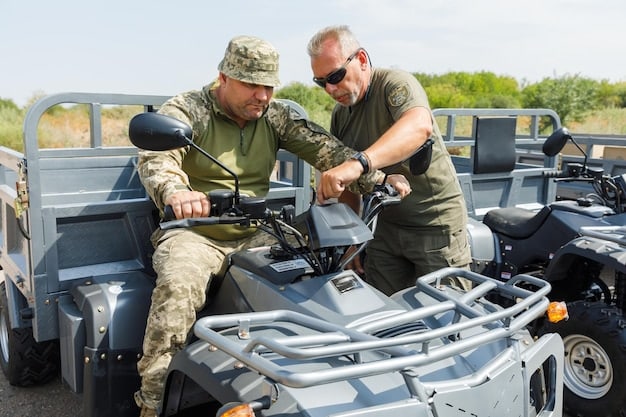
Another critical consideration is power. Depending on their propulsion system, RCVs will require either fuel or advanced battery charging infrastructure. For electric or hybrid systems, this could mean deploying mobile charging stations or developing faster, more efficient battery technologies that can withstand harsh combat conditions. Resupply missions will need to account for both human and robotic needs, potentially including autonomous resupply vehicles to support the RCVs themselves. The logistical footprint might initially increase as new systems are integrated, but the long-term goal is to achieve greater efficiency and reduce the human element involved in dangerous resupply operations. Ultimately, rethinking logistics for an RCV-integrated force is about ensuring these invaluable assets can contribute to the fight without becoming a logistical burden.
Ethical, Legal, and Social Considerations of RCVs
The integration of Robotic Combat Vehicles into infantry tactics by 2025 raises a myriad of ethical, legal, and social (ELS) considerations that extend beyond the purely technical or tactical. As machines assume increasingly autonomous roles on the battlefield, profound questions arise regarding accountability, civilian protection, and the very nature of human conflict. Addressing these concerns proactively will be crucial for the responsible deployment and public acceptance of RCVs.
The development and use of RCVs must be guided by strong ethical frameworks to ensure they adhere to international humanitarian law and the laws of armed conflict. Commanders and policymakers face the challenge of defining the boundaries of autonomous decision-making in lethal engagements. While current doctrine emphasizes human oversight “in the loop” or “on the loop” for lethal applications, the increasing sophistication of AI may challenge these distinctions. The potential for RCVs to reduce human casualties for one’s own side must be weighed against the risk of dehumanizing warfare or increasing the likelihood of conflict through reduced risk aversion.
Defining Accountability and Restraint in Robotic Warfare
A primary ethical concern revolves around accountability. If an RCV commits an error or causes unintended harm, who is responsible? Is it the operator, the commander, the programmer, or the manufacturer? Clear legal frameworks are needed to establish lines of responsibility, especially as RCVs become more autonomous. Additionally, the potential for algorithmic bias or unforeseen system failures needs to be rigorously addressed through robust testing and transparent design. Society must grapple with the implications of machines making life-or-death decisions, even if under human supervision. Public perception and trust are also vital; fear of “killer robots” could undermine the legitimacy of RCV deployment, necessitating comprehensive public education and engagement. The long-term psychological impact on soldiers operating alongside autonomous systems, and the implications for the human element of warfare, are also areas that require careful study and consideration.
Training and Doctrine Evolution for the Robotic Age
The successful integration of Robotic Combat Vehicles into infantry tactics by 2025 hinges not just on technological advancement, but equally on a fundamental transformation in training methodologies and military doctrine. The traditional infantry soldier, trained primarily for human-centric combat, will need to evolve into a robotic-human team member, requiring new skill sets, operational procedures, and a revised understanding of their role on the battlefield. This evolution will be a continuous process, adapting as RCV capabilities mature and as adversaries develop countermeasures.
Cultivating the Robotic Warrior: New Skill Sets for Infantry
Infantry training programs will need to be revamped to incorporate RCV operation, maintenance, and tactical integration. Soldiers will require proficiency in controlling robotic platforms, interpreting sensor data, and maintaining optimal communication links. This might include skills in remote vehicle operation, basic troubleshooting of autonomous systems, and an understanding of artificial intelligence capabilities and limitations. Beyond technical skills, future infantry will need to develop a heightened sense of tactical synergy with their robotic counterparts. This means understanding how to leverage RCV strengths—such as persistence, endurance, and target acquisition—while mitigating their weaknesses and ensuring seamless coordination with human actions.
New doctrine will also emerge, outlining best practices for manned-unmanned teaming (MUM-T) at every level, from individual soldier to platoon and company. This will cover everything from movement techniques and battle drills to casualty evacuation and intelligence gathering employing RCVs. The Army will likely develop specific “playbooks” for various combat scenarios, detailing how RCVs can be used to enhance infantry effectiveness while minimizing risk. The goal is to move beyond simply controlling a machine to truly integrating it as a force multiplier, where the sum of human and robotic capabilities far exceeds their individual parts. This transformation will be iterative, shaped by field exercises, feedback from soldiers, and ongoing technological developments.
| Key Impact | Brief Description |
|---|---|
| 🤖 Enhanced Reconnaissance | RCVs will significantly improve infantry’s ability to scout ahead, gather intelligence, and detect threats without exposing human soldiers to direct danger, providing crucial real-time situational awareness. |
| 💥 Increased Firepower & Lethality | RCVs will act as mobile fire platforms, delivering direct fire support, engaging targets, and suppressing enemy positions, augmenting the organic lethality of dismounted infantry units. |
| 🛡️ Soldier Protection & Risk Mitigation | By taking on dangerous tasks, RCVs will serve as mobile shields and forward elements, reducing human exposure to enemy fire, IEDs, and CBRN threats, leading to fewer casualties. |
| 📚 Training & Doctrine Evolution | New training programs and tactical doctrines will be essential to foster effective Manned-Unmanned Teaming (MUM-T), integrating RCVs seamlessly into infantry formations and operations. |
Frequently Asked Questions About Robotic Combat Vehicles
A Robotic Combat Vehicle (RCV) is an uncrewed ground vehicle developed by the U.S. Army to operate autonomously or remotely, providing support to infantry units. RCVs are designed to enhance reconnaissance, provide direct fire support, and reduce soldier exposure to battlefield risks, fundamentally reshaping ground combat tactics.
RCVs will enhance infantry lethality by acting as mobile weapon platforms capable of mounting various armaments, from machine guns to anti-tank missiles. They will provide additional, sustained firepower on the front lines, allowing infantry to engage a wider range of threats and maintain momentum during assaults without exposing human operators.
RCVs will significantly improve soldier protection by operating in high-risk areas first, acting as mobile shields, and performing dangerous tasks like reconnaissance or breaching. This strategy aims to reduce direct human exposure to enemy fire, improvised explosive devices, and chemical threats, thereby minimizing casualties and increasing troop safety.
No, RCVs are designed to augment and support human infantry soldiers, not replace them. The Army’s vision is centered on Manned-Unmanned Teaming (MUM-T), where robots work alongside humans as force multipliers, taking on dangerous or repetitive tasks. Human decision-making and ethical judgment remain paramount in combat operations.
The U.S. Army is exploring different variants of RCVs based on size and payload: RCV-Light (RCV-L) for reconnaissance, surveillance, and target acquisition; RCV-Medium (RCV-M) for a balance of RSTA and direct fire; and RCV-Heavy (RCV-H) for robust fire support and specialized heavy tasks.
The Robotic Frontier: Shaping the Future of Infantry
The integration of Robotic Combat Vehicles by 2025 is set to usher in a new era for U.S. Army infantry tactics. Far from being a mere technological add-on, RCVs will fundamentally reshape how dismounted soldiers operate, engage, and survive on the battlefield. Through enhanced reconnaissance, increased lethality, and unparalleled soldier protection, these robotic partners will enable infantry units to be more agile, effective, and resilient in the face of evolving global threats. The journey ahead involves not only perfecting the technology but also continuously adapting doctrine, training, and ethical considerations to ensure that this robotic frontier genuinely strengthens the human element of warfare, prioritizing the safety and success of the soldier. The future of infantry is collaborative, dynamic, and undeniably robotic.
